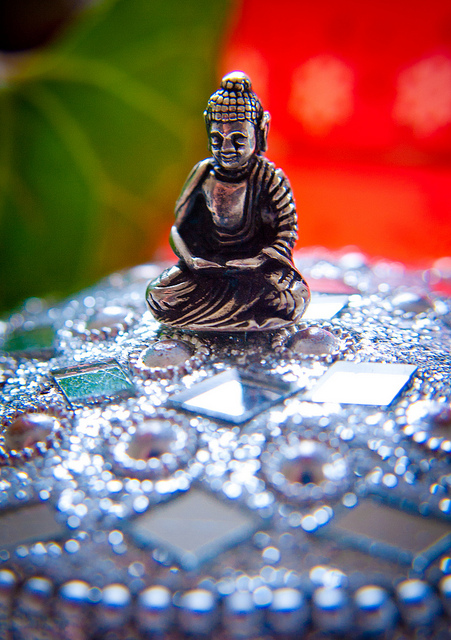Have you ever wondered why you can’t stick to something you set out to do?
Maybe you just disregarded it as a lack of willpower, beat yourself up and then set out on a more restrictive journey, or just decided that it was too hard and gave into the desires of the lower mind.
One definition of yoga is to move from lower desires to higher ones, but this is not without obstacles and the same distractions that show up in our yoga practice show up in our lives. When I a mention the word “yoga,” I am discussing it as the “intimacy of being,” our ability to weave our individual selves with all living beings, nature, and our highest intellect (or source) while living in a complex world.
This yoking happens to all of us who allow ourselves to learn, soften or be molded from our obstacles, either from maturing into a deeper understanding of human nature, or the blossoming awareness that arises from a daily practice.
The way yoga has been practiced and is being practiced in the west, with our habit of instant gratification, has lent itself for us to discover what yoga is not. The work of yoga is to continue on the path, continually dropping the ego like bread crumbs to be eaten by the crow, so that we may develop a deeper insight into the nature of the mind, our attractions and repulsions, and the obstacles that are not ours alone.
The other day as I was completing a retreat to Menla, I decided to take a walk on the trails alone, something that, to my surprise, I have never done in 39 years of living. I prefer to rely on others to lead the way because it is easier to simply enjoy life and not take responsibility for anything. Although this is my “nature,” it is not my dharma, as I have been asked to lead.
Leadership takes courage and continuously asks me to wake up and not be distracted. To go against the grain of our natural tendency is what makes life a struggle, but to be persuaded by our natural tendencies is what makes life suffering.
In my haste to go for a walk, without truly understanding the path, I found myself—more aware, moving forward and when approaching obstacles and wanting to turn around, trusting that someone before me had accurately marked the territory.
Where does it end? Which paths does it cross with? What are the landmarks that I will see on the way so that I know I am still on the right trail? These were questions I asked as I continued.
As we walk, each of us on the path together but alone, we should all be asking questions, like the child who keeps asking why? What do they find at the bottom but a tired, frustrated parent who thinks they know, or a loving teacher who says “I don’t know,” understanding that the questions are the answer. I realized that all of these questions, although they were mine, were to be asked for another.
Everything we learn and obtain is to be given away. This is the true definition of leadership and love.
My intention lately, always rooted in one of truth, is to not hold back, which also echoes “Do not be distracted.” Our distractions, when not conquered, lead to addictions and we become blind with desire. When we lean into the present moment, without holding back, we may encounter more obstacles than before but as an opportunity to acquire more knowledge as we travel our individual paths. They may look different and hopefully they do, but we are all doing it for each other. We must beware and be aware of the obstacles that make us want to turn around and give up this path to awakening, so we can rejoice in their appearance to show us the light.
Patanjali offers us a list of distractions. It is important to change our view of obstacles from ones that prevent and block us from growth, to the thing that allows us to grow when we move beyond.
The first is Vyadhi, or disease.
This is disease in the body. If there is disease in the body, it is challenging to sit and meditate. We may need to make lifestyle changes as the first step to our yoga practice, the practice of balancing ourselves in this complex world. This may mean changing our diets, using ayurveda remedies, or seeing a doctor.
The next is Styana, which is a laziness of the mind.
These are the days when you simply do not desire to make change because of a lack of vitality. Pranayama (breathing practices) are wonderful tools to refocus the mind and move the heavy veil that blocks our enthusiasm and sustainability, for continuity on our path.
Samsaya is a feeling of uncertainty.
This is like going to a restaurant that has too many choices on the menu. Google and big box stores have all given us this feeling. Yoga methods can be like this. I have had this experience at yoga conferences when you go to one teacher and they tell you how to practice one way, and then the next hour you are learning that is the “incorrect way” and you should be practicing “this way.”
This happens when we do not dig deep wells with one teacher for a long time and cannot see the truth that underlies all methods. When we dig deep wells with our teachers, water flows from all directions.
Pramada, haste, is an obstacle that I place on the path regularly.
When we are hasty and without presence and pause, we sever the ties between us and the divine. In my opinion, it is because of haste in this culture, that we all feel a lack of time. We rob ourselves of precious moments of spontaneity and joy that comes from connection with the divine, until we are walking around like hungry ghosts. Listen. The presence of pause and gratitude have been my keys to unlock this obstacle.
Alasya, is exhaustion from the laziness of mind.
This can even occur from the attachment to bliss. I have had this obstacle arise in my meditation and asana practices. When we attach ourselves to the illusion of bliss, we continue to seek out blissful experiences, rather than accepting that to be human is to suffer, because we are continuously called to go against “our nature” to find balance and harmony.
If we understand the bliss or happiness that sells books does not exist as a permanent, however a deeper understanding and non-attachment to bliss is what keeps us content. This contentment is the oil in our lamp that fuels the fire of compassion for all beings, rather than seeking out the blissful moments for ourselves.
Avirati: distraction or cravings.
This is to beware or be aware of our hankerings. I could write a book on this as I am a person who lives on the inhale, excited about life, which can also translate into addictions and excitation of the senses. What’s next? Always living in the future prevents us from the spontaneous joy of the present moment.
This is the example of “fool’s gold.” We would rather trade gold to get a piece of candy right now. The subtle body practice of tantra has been my greatest tool for this obstacle of long-term addictions, yet just to pause and observe the sensations of your senses during the craving allows some space between you and the craving. When we realize that we are not the craving we give ourselves space to see it as temporary and have a moment to choose the moment.
Bhrantidarsana is a false perception of all that we have achieved.
It is the moments when we think we know it all and therefore it leads to the next obstacle with is Alabhabumikatva, not holding onto the ground or level we have achieved. This is the cycle of suffering that we as humans face and must embrace.
Life is not linear, and the ground that we have gained today may be shaken from under us tomorrow if it is not rooted in love. If it is rooted in love and understanding then we realize that even though we have fallen back on the path we are always gaining in the wisdom and intimacy with the world and each other. If it is rooted in the ego then we must retrace our steps and the bread crumbs that have been left uneaten on the path until the truth is unearth and we have digested the truth of our experience of obstacles and a deeper understanding of humility and humanity.
Relephant Read:
Yoga Unveiled: A User’s Guide to the Yoga Sutras of Patanjali.
Author: Dani McGuire
Editor: Catherine Monkman
Photo: Holly Victoria Norval/Flickr











Read 0 comments and reply